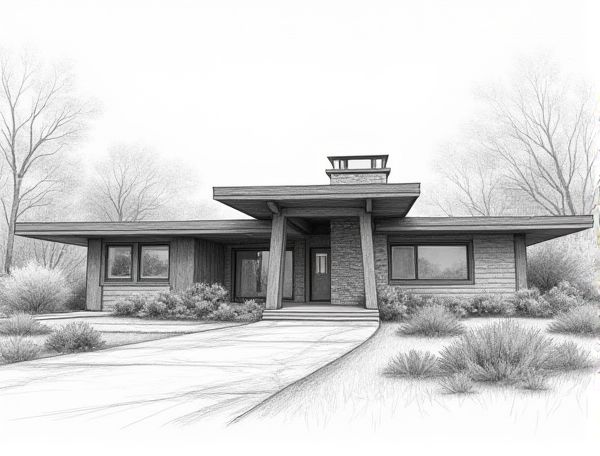
Photo illustration: Prairie-style home design with cantilevered overhangs
Prairie-style home design features distinctive cantilevered overhangs that extend the roofline horizontally, creating a seamless connection between indoor and outdoor spaces while providing shade and shelter. Explore the article to discover how these architectural elements can transform Your home's aesthetic and functionality.
Introduction to Prairie-Style Home Design
Prairie-style home design emphasizes horizontal lines, flat or hipped roofs with broad overhanging eaves, and integration with the surrounding landscape, reflecting the architectural philosophy pioneered by Frank Lloyd Wright. Characterized by open floor plans, natural materials, and earth-tone color palettes, this style promotes harmony between indoor and outdoor spaces.
Key Characteristics of Prairie Architecture
Prairie architecture is characterized by low-pitched roofs with wide overhanging eaves, horizontal lines that blend the structure with the surrounding landscape, and open floor plans promoting natural flow and spaciousness. Expansive windows and the use of natural materials like wood and stone enhance harmony between indoor and outdoor spaces. Your home designed in this style emphasizes simplicity, craftsmanship, and a strong connection to nature.
The Significance of Cantilevered Overhangs
Cantilevered overhangs enhance your home design by providing shaded outdoor spaces while protecting interiors from direct sunlight, improving energy efficiency. These architectural features also add visual interest and structural elegance, elevating the overall aesthetic appeal of your property.
Historical Roots of Prairie-Style Homes
Prairie-style homes originated in the early 20th century, heavily influenced by architect Frank Lloyd Wright and the Arts and Crafts movement, emphasizing harmony with the natural landscape. These designs feature horizontal lines, flat or hipped roofs with broad eaves, and open interior spaces that promote flow and connectivity. The style reflects a distinctly American architectural identity, rooted in the Midwest's expansive prairie landscapes.
Frank Lloyd Wright’s Influence on Prairie Design
Frank Lloyd Wright revolutionized Prairie design by emphasizing horizontal lines, open floor plans, and integration with the natural landscape, creating homes that reflected the American Midwest's expansive terrain. Your home design can benefit from Wright's principles by incorporating organic materials and seamless indoor-outdoor transitions to achieve a harmonious and timeless aesthetic.
Materials Commonly Used in Prairie-Style Homes
Prairie-style homes commonly feature natural materials such as wood, brick, and stucco to emphasize organic harmony and craftsmanship. Your design can benefit from the use of wide oak trim, horizontal brickwork, and earthy stucco finishes to create the signature low, flat rooflines and integrated interior-exterior flow characteristic of this architectural style.
Integrating Cantilevered Overhangs for Modern Living
Cantilevered overhangs enhance modern living by providing shade, expanding outdoor space, and improving energy efficiency in your home design. These architectural features create sleek, floating rooflines that protect interiors from sun and rain while adding a striking visual appeal to your property.
Energy Efficiency Benefits of Overhang Features
Overhang features enhance your home's energy efficiency by providing shade that reduces cooling costs during hot months and allowing natural light to warm interiors in colder seasons, optimizing thermal comfort. Properly designed overhangs minimize reliance on artificial heating and cooling systems, leading to significant energy savings and a reduced carbon footprint.
Landscaping to Complement Prairie Aesthetics
Incorporating native grasses and wildflowers into landscaping enhances the natural flow of prairie aesthetics, promoting biodiversity and sustainability. Strategic placement of stone pathways and rustic wooden features harmonizes with the expansive, open feel characteristic of prairie design. Selecting drought-resistant plants optimizes water conservation while maintaining an authentic prairie landscape ambiance.
Tips for Designing Your Own Prairie-Style Home with Cantilevered Overhangs
Incorporate cantilevered overhangs in your prairie-style home design to enhance natural shading and protect exterior walls from weather elements, improving energy efficiency. Use horizontal lines and earthy materials like brick or wood to emphasize the architectural style's connection to the landscape while maximizing the dramatic effect of extended rooflines.
 homedesy.com
homedesy.com